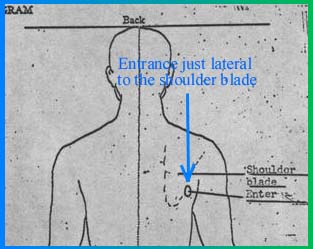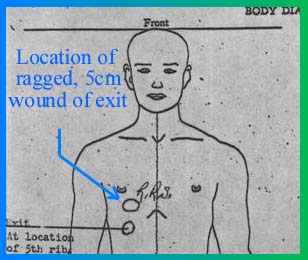
|
|
Governor Connally
|

|
|
Texas Governor John B. Connally, seated slightly below, in front and slightly to the left of Kennedy on a jumpseat, was critically wounded during the shooting in Dealey Plaza. The only damage to the limousine came in the form of a cracked windshield and a dent to the chrome stripping above the windshield. Since these trajectories would be a stretch for a bullet passing through the soft tissue of Kennedy's neck, Governor Connally's wounds were questioned to have been caused by the bullet that exited through Kennedy's neck.
|
|
The Governor's Wounds
|
|
Governor Connally was lucky to live after receiving the shot to the back that he had. In his Warren Commission testimony, Governor Connally said that he had heard the first shot and recognized it immediately as a gunshot. He tried to look at the President, but never caught sight of him. After a couple of seconds, he was hit by a second shot that he could not hear. He described the wounding as though he had been punched in the back. That bullet exited his chest in the right chest, below and to the left of his right nipple. He also sustained a wound to his right wrist that shattered the radius bone of the distal forearm. In addition, he had a slight, penetrating wound of the left thigh. His wounds are probably the most significant part of the Single Bullet Theory. But, to understand the Warren Commission's theory, you have to understand Governor Connally's wounds.
|
|
The Back Wound
Governor Connally was hit in the back, just to the left of the right axillary fold which makes up the posterior (rear) border of the armpit. This wound was approximately 1.5cm at it's greatest width and elliptical in shape. The shape was markedly different from President Kennedy's 7mm x 4mm entrance wound. This left two possible causes. First, he was hit by a bullet that was tumbling. Second, the bullet struck Governor Connally at a tangential angle creating the elliptical wound. The latter of the two indicates that the bullet would have to it Governor Connally at a moderate angle. This angle would have to be either a very high angle, or from a high angle from the side. Now, working with the evidence...3 audible shots, 3 shells round on the 6th floor of the TSBD and a matching rifle...the Warren Commission had to ascertain the likelihood that Governor Connally's wound would be markedly different from President Kennedy's if the bullets originated from the same location. Not very likely. In addition, the path through Connally's chest did not indicate a high angle of entry. It indicated a low angle, back to frong. Take a look at the face sheet indicating the location of the wound.
|
 |
As you can see, the bullet entered Connally's back in the mid-thoracic area, just to the right of the shoulder blade and to the left of the armpit. Dr. Shaw described the wound in great detail in his Warren Commission testimony. The bullet entered to the right of the shoulder blade. Then, at the level of the mid-axillary line (about the middle of the armpit), it fractured 10cm of the fifth rib, pushing bone fragments into the right middle and lower lobes of the lung. Dr. Shaw described the bullet traveling along the 'angle' of the fifth rib, which is a downward trajectory. In addition, the entrance was a substantial distance higher than the exit, indicating a downward trajectory.
Dr. Shaw also made an important statement. No bullet fragments were found during the operative procedure, nor were any seen on the x-ray. Therefore, the bullet entered and exited intact. Dr. Shaw noted that the ribs are not dense bones and did not offer much resistance to a high velocity projectile.
|
|
The Chest Wound
The chest wound was obviously an exit wound. It had a ragged, 5cm wound located below the right nipple and slightly to the left. This indicates a trajectory that was downward and followed a slight right to left angle from the entrance to the exit wound. Again, we have a trajectory for a bullet above, behind and to the right of the victims. Yet, the two entrance wounds were markedly different. In fact, it is a stretch of the imagination that allows such an elliptical entrance wound with the known bullet tract. The bullet fractured the 5th rib, indirectly lacerated the middle lobe of the right lung and exited leaving a large 5cm, ragged exit wound below the right nipple and to the left. The bullet caused small splinters of bone to be blown into the lung. Yet, no fragments of a bullet were found. Whatever went in came out intact.
|
|
The original diagram was drawn incorrectly. During his WC testimony, Dr. Shaw was asked to draw approximately where the exit wound was on Connally. He did so, and initialed next to his addition to the drawing. You can see his initials R.R.S. next to the larger circle made to represent the 5cm, ragged exit wound.
This wound of the chest caused the right lung to collapse. This causes a 'sucking' wound of the chest where air is drawn in through the exit wound in an effort to inflate the lung. The medical staff had speculated that Governor Connally may have 'sealed' the exit wound with his arm, allowing him to breath en route to the hospital. Governor Connally did not know about the wrist or leg wound until the next day after he regained consciousness.
|

|
|
To summarize the medical evidence, I will offer the following. The bullet entered Governor Connally slightly lateral to the scapula, or shoulder blade, but medial to the axillary fold making up the rear border of the arm pit. This is the area where the ribs curve around to the front. Traveling at a downward and right to left trajectory, it shattered 10cm of the 5th rib, from the midline, anteriorly, and lacerating the middle lobe of the right lung- causing the lung to collapse. The bullet exited, leaving no trace fragments, below and slightly to the left of the right nipple. The exit wound was ragged and measured 5cm across. For an illustration showing a sample trajectory through the anterior chest, click here. For a look at the posterior entry and rough path, click here.
In essence, the wound was caused by one bullet, traveling down and to the left. It created only one wound tract. The lack of multiple wound tracts and metallic debris indicates only one possibility- the bullet left intact and would continue downward and to the left. This leaves multiple possible landing points. The medial side of his right leg (although he'd have to be contorted for this), his left leg, his right or left arm, hand and wrist, the seat, the floor or the seats in front of him. To leave the car entirely would definitively label it a Magic Bullet. No damage was found to any portion of the interior of the car, save for a spidering crack in the windshield and the chrome stripping above the windshield. That damage is best explained by the fragments created during the headshot, exiting from the President's head and hitting the windshield and chrome stripping. The bullet that left Connally's chest was intact and heading downward and to the left.
|